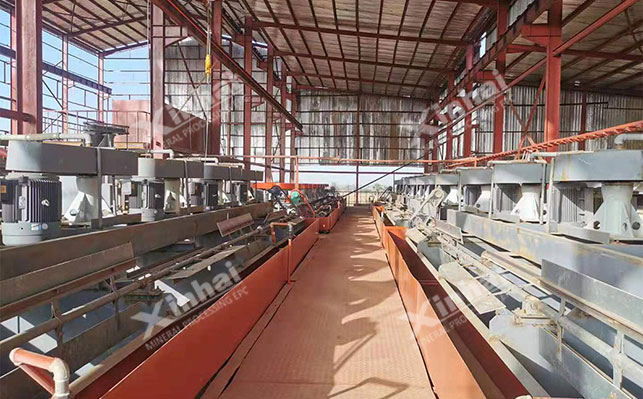Flotation is the most commonly used mineral processing method, among which the common flotation processes include priority flotation, mixed flotation, partial mixed priority flotation, equal flotation, asynchronous flotation, branch serial flow flotation, flash flotation, rapid flotation, and so on. The flotation process mainly includes grinding, slurry mixing and dosing, flotation separation and dehydration process of foam products and tailings products after flotation.
1. Grinding: Generally, before entering flotation, it is necessary to grind the mineral to an optional particle size range (to -0.1mm) through grinding equipment such as a ball mill, rod mill, or autogenous mill. If the mineral particles are too large during flotation, they may easily fall off, or if the mineral particles are too small, they may easily adhere to the surface of the coarse particles, reducing the floatability of the coarse particles, which may reduce flotation efficiency. Therefore, the grinding particle size should be determined based on the actual situation of the ore (too coarse refers to greater than 0.1mm, and too fine refers to less than 0.006mm).
2. Sizing and dosing: Determine suitable flotation reagents based on different ore properties and mineral particle sizes, and mix the reagents with the pulp to change the physical and chemical properties of the mineral medium, expand the hydrophobicity between flotation minerals, and facilitate subsequent separation operations.
3. Flotation separation: After dosing and stirring, the pulp enters the flotation machine, and a large number of bubbles are formed in the flotation machine through an air blowing device (or the flotation machine has its own suction function), allowing useful minerals or gangue minerals to adhere to each other, and float with the bubbles to achieve flotation operations (the flotation operation process consists of rough selection, sweeping, and concentration).
4. Concentrate/Tailings Dehydration: The concentrate (gangue or other minerals during reverse flotation) and bottom tailings of the floats are dewatered at different stages using various concentration and dehydration equipment.

1. Preferential flotation process
The preferential flotation process is a method of sequentially selecting useful minerals. When the processed minerals contain two or more useful components (polymetallic minerals), optimal flotation is used to select one useful mineral, suppress the other useful mineral, and then activate the suppressed mineral for flotation. It is mainly used when the embedded particle size is relatively coarse, and the content of useful minerals in the mineral is high, or the floatability differences among useful minerals are large, it is advisable to use a preferential flotation process.
2. Mixed flotation process
The mixed flotation process is a process in which various useful minerals are first floated together and then separated for flotation when there are two or more useful minerals in the mineral. It is mainly suitable for polymetallic ores with low mineral grade and aggregation of useful minerals.
3. Partial mixed preferential flotation process
This process is a process of flotation based on the optimization of flotation and mixed flotation, and according to the characteristics of the ore. Among the minerals in mixed flotation, some minerals inhibit other minerals, and then carry out activated flotation. First, carry out mixed flotation, and then carry out sequential flotation. It is mostly suitable for minerals in which the floatability of several useful minerals is relatively close and the floatability of several minerals is significantly different.
4. Isoflotation process
Isofloatation is based on the floatability (sameness or similarity) of minerals to divide the flotation sequence. Useful minerals are divided into two parts, namely, easy to float and difficult to float, and then flotation is carried out sequentially according to the degree of difficulty. Most suitable for handling the same mineral.
5. Asynchronous flotation process
This process is based on an equivalent flotation process, which mainly performs flotation based on differences in ores or according to the special requirements of the concentrator for the product. It is mainly suitable for minerals with lead as the main raw ore and less sulfur.
6. Branch and serial flow flotation process
Branch serial flotation is to first divide the original pulp into two or more branches. The foam of the former rough separation and the original pulp of the latter branch are combined for rough separation, and then they are properly "connected in series" with corresponding reagent system. It is mostly suitable for concentrators with more than two flotation series.
7. Flash flotation process
This process involves adding a single cell flotation process to the grinding circuit. Before conventional flotation, a portion of the qualified concentrate is selected by flotation. The purpose of this process is to reduce the loss caused by excessive wear. Most suitable for embedding sulfide minerals with uneven particle size and containing precious metals.
8. Rapid flotation process
According to different particles of minerals (based on the difference in mineral flotation speed), fast flotation uses a shorter flotation time to first select the minerals with a faster flotation speed. Most suitable for selected minerals with uneven particle size distribution and requiring regrinding (coarse concentrate or intermediate ore).
The flotation process has a wide range of applications and good beneficiation indicators, but when determining the beneficiation process and beneficiation process, it should be formulated in accordance with the beneficiation test data to avoid blindly applying the beneficiation schemes of other concentrators, so as to avoid causing resource waste and profit loss.